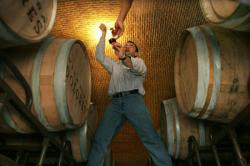 |
 |
 |
 News Around the Republic of Mexico | September 2005 News Around the Republic of Mexico | September 2005  
Mexican Wines Make a Comeback in Land of Tequila
 Reuters Reuters


| | Jose Antonio Llaquet, enologist of Spanish wine giant Freixenet's Mexican vineyard, tastes a wine in the vaults of the winery in Ezequiel Montes, Mexico. Since the 1980s, accomplished Mexican winemakers have set to restore respectability to Mexico wines. |
Ensenada, Mexico – Long before Mexico gained fame for its cool bottled beers and searing shots of tequila, pioneering winemakers were planting vines and laying down the New World's first vintages there.

Banned in the 1600s by Spain and subsequently eclipsed by local brewers and distillers, the once flourishing industry is now making a comeback in three semi-desert valleys a few miles south of the U.S. border.

Twenty-two wineries dot the San Vicente, Santo Tomas and Guadalupe valleys, close to the Pacific coast resort of Ensenada in Baja California state, and are winning critical attention both in Mexico and abroad.

Production is small at just 1.5 million cases a year, but the reds and whites produced in the region of 7,400 acres have won more than 20 medals at international fairs in Europe and the Americas in the past decade.

Aided by wine technicians and enologists from as far afield as Chile and Italy, Mexican growers have invested millions of dollars in their vine stocks and in state-of-the-art equipment, to put the local wine industry back in business.

"When people think of Mexico they think of beer and tequila, but winemaking is having its renaissance," Baja California Winemakers Association manager Blanca Acosta said as she drove through rows of vineyards near Ensenada.

"The climate and soils are producing some really world beating wines," she added.

Laboratory By The Sea

The first crus were grown in Mexico in the 1520s in the parched deserts of what is now northeastern Coahuila state, only to be banned by the Spanish crown in 1699 after exports from the Old World began to suffer.

Mexico's revival began in the late 1970s in the valleys near Ensenada – which account for around 90 percent of all production – as winemakers intrigued by the cool maritime microclimate and arid soils began trying out varietals.

"What you see here is a living experiment to find the ideal wine for the region. Not just in terms of quality, but in terms of the soil, the weather and pests," says Hans Backhoff, the director of the local Monte Xanic winery.

The maritime microclimate, salt-rich soils and limited water supply concentrate the sugars in the grape to produce wines with a medium to high alcohol content.

Aside from the standard Chardonnay and Cabernet Sauvignon varieties of the New World wine repertoire, Mexican growers like Backhoff are experimenting with less common types such as French Chenin Blancs, Italian Nebbiolos and Californian Zinfandels.

Others winemakers in the valleys have planted pockets of French Malbecs and Spanish Tempranillos and have even used dried grapes to make sweet Passito dessert wines.

"Mexican culture is a mosaic with many differences, and it's the same with the wines," enologist and wine expert Hugo D'Acosta said in a shady grove close to one Guadalupe valley winery.

"Here we have many different wines and many different blends showing just how diverse we are," he added.

Taking On Tequila

Many Mexicans, particularly in the traditional tequila and mezcal belts in Jalisco and Oaxaca states, have little tradition of wine drinking, preferring a shot of their fiery local liquor to accompany a meal.

But Baja California winemakers say interest in wine is spreading in Mexico, with consumers in Mexico City, Guadalajara and Monterrey beginning to show interest in local wines priced at between $8 and $40 a bottle.

"Mexicans are educating themselves and becoming serious consumers of wine, and sommeliers in Mexico City are starting to take notice," winemaker Donald Miller told Reuters in the cool cellar of his Adobe Guadalupe winery.

The wines, which local makers are blending and laying down in French and American oak barrels to layer their punchy fruit bouquet, have yet to make an impact in U.S. and European export markets flooded by Argentine and Chilean wines.

But wine buffs and tasters from across the border in California are coming down to taste at Baja California wineries, and are taking note.

"The quality of the wines coming out of the Guadalupe valley have increased 100 fold since the early 1990s," Californian wine lecturer Dominic Colagelo said as he swilled a glass of Cabernet Sauvignon in the shady Monte Xanic winery.

"It is just a matter of another five to 10 years, and they will be producing some really super, super wines," he added. | 
 | |
 |



